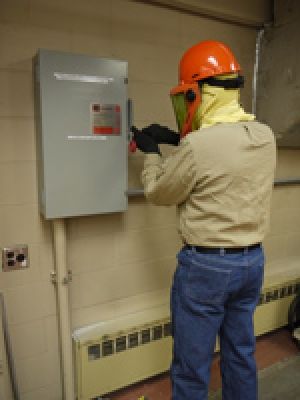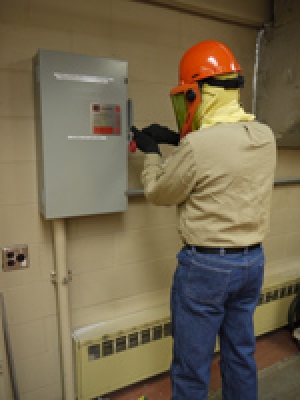
Five PPE Safety Challenges

In 2012, both NFPA 70E and the NESC will change personal protective equipment (PPE) and give guidance to utilities and industrial electrical workers that they haven’t previously had. Under NESC 2007, low-voltage (LV) work in utilities had only basic coverage. If 4 cal/cm² arc flash PPE clothing was worn, the company was in compliance. There was no requirement to do an arc flash assessment if 4 cal/cm² clothing was used.
The new NESC will require calculations or the use of new tables even for LV work. The tables in NESC are arc flash calculation tables that give a range of energy levels for certain types of equipment and within a voltage range. If a company has a fault current of less than 51 kV, these tables characterize exposure energy in 500V padmounts, self-contained meters, transformers and cabinets to 20 cal/cm² based on Electric Power Research Institute (EPRI) and utility-based testing. This testing takes advantage of better understandings of arc flash physics that the IEEE 1584 standard didn’t have funding to take advantage of. Arc plasma cannot travel as far from the source as the older Lee equations in IEEE 1584 expected. This could be corrected in the new version as arc plasma and the plasma cloud front are the key energy carriers in arc flash events (see Stokes and Sweeting’s IEEE papers). If companies do not use the tables, they must perform some type of arc flash calculation. Other LV utility equipment requires protection to different levels – 4 cal/cm² or greater depending on equipment type or voltage.
Challenge 1: How Do You Perform Your Arc Flash Assessment?
Both standards have two methods: tables and formulas or formula recommendations. The tables in the 2012 NFPA 70E have a major upgrade, are clearer to use and also make it clear that the hazard risk categories (HRC) do not apply to calculations. The risk must be determined as part of the hazard assessment. NESC 2012 really improves guidance in the area of LV work, but still makes no real recommendations on PPE other than clothing and shock protection.
Challenge 2: Eye and Face Protection
NESC 2012 still requires no face protection. However, by giving guidance for >2 cal/cm² in LV work, it begs the question of face protection since OSHA has required eye or face protection from arc flash hazards since 1991. OSHA 1910.335(a)(1)(v) states, “Employees shall wear protective equipment for the eyes or face wherever there is danger of injury to the eyes or face from electric arcs or flashes or from flying objects resulting from electrical explosion.”
Following are other major NFPA 70E changes for face protection that will be in place in 2012:
1. The NFPA 70E standard redefined the arc flash hood to allow for balaclava/goggle assemblies – offered by National Safety Apparel and Paulson International – but the committee stopped short of recommending these systems when using the HRC tables. HRC 3 and HRC 4 still require beekeeper-style hoods with facepieces.
2. When >12 cal/cm² exposures are anticipated, an arc flash hood is required in the 2012 NFPA 70E standard. Before, only HRC categories had requirements of when to wear a hood, but the HRCs do not officially apply when companies have done calculations. This confusion is perpetuated by consultants, software systems and misunderstandings of NFPA 70E table 130.7(C)(10), which only applies to the use of table 130.7(C)(9). This is not to say a company would not benefit from definitions like the HRC categories, but they are nonmandatory when calculations have been performed. Some companies use levels similar to HRC categories.
3. HRC 2 will include a balaclava under the face shield, eliminating the need for HRC 2* as they are now the same. This one change will move many companies away from using the tables to calculating because the HRCs are nonmandatory when calculating. However, proximity of the face to the arc flash should be considered when deciding whether or not to use a balaclava with the face shield.
4. The balaclava in the 2012 NFPA 70E has now been defined as “an arc-rated hood that protects the neck and head except for facial area of the eyes and nose,” and is required for HRC 2 and in a proposal for any exposures from 1.2 cal/cm² to 12 cal/cm².
Challenge 3: 20-Cal LV Protection for More Workers (480V Meters and Padmounts)
Protection to 20 cal/cm² has two challenges: clothing and face protection. Many options are out there, but none is perfect. There are shirts with double-layer arms and fronts that could solve the upper torso problem if a company deems that the exposure is mostly from the front – this is commonly the case – or companies could provide layered systems. The lower torso is not much of an issue since arc-rated jeans commonly reach 20 cal/cm² in protection, and double-layer front jeans and arc-rated carpenter pants with a double-layer front are available on the market. Another option is to provide a coverall, but many utilities are moving to providing arc-rated T-shirts with a long-sleeve shirt to allow greater comfort and provide better upper torso protection. Long-sleeve T-shirts are available, but some companies choose short-sleeve T-shirts and accept the risk of slight burn from the elbow to the lower bicep. Others are providing welding sleeves, which cover the whole arm, or rubber sleeves, which provide excellent protection unless they ignite.
Challenge 4: Hand Protection When Shock Protection is Not Needed
NFPA 70E added a minimum thickness requirement of 0.7 mm on leather gloves. This has already caused some issues – some leather protectors have not met this requirement – but was added because ASTM F18 has yet to approve a standard method to arc rate gloves. While leather and some rubber gloves have been shown to protect quite well, most of the experience is with U.S.-made rubber gloves, and several companies are importing rubber gloves meeting ASTM D120. Few if any of these have been tested. Other gloves are now being tested with a new arc test method specifically for gloves using ASTM F1959 and a modified panel, but this has no standard number since political struggles in ASTM have prevented a method from being approved. Most of the battle is about the “down the road” issue of testing all rubber gloves – which a few utility consultants and some glove importers oppose – even though some rubber gloves have been proven to ignite at <20 cal/cm².
The utility experience with Class 2 rubber gloves is excellent, with very few burning through their gloves and very few glove ignitions. However, the imported gloves have not been proven in this manner, and some of those companies are still opposing any testing of the gloves. Expect an ASTM glove test method in 2012, but a glove specification for arc flash gloves will take some time. Voltage-rated gloves with leather protectors are already acceptable for arc flash protection under NFPA 70E. NESC has no mention of hand or face protection from arc flash, leaving this detail to the utilities’ discretion.
Challenge 5: Layering Data
More savvy use of NFPA 70E and new NESC requirements citing >20 cal/cm² needs in utilities will move companies to abandon arc flash suits for some work >8 cal/cm² and look at in-between systems. Arc flash suits will still be used, especially for 40 cal/cm² exposures. However, many companies are using coveralls with a hood over daily wear with a hood for higher-level exposures. This makes use of the arc flash daily wear and handles comfort and heat issues while still providing arc flash protection.
NFPA 70E eliminated confusion from the 2000 and 2004 versions, which implied that all flame-resistant layers were equal in protection and that you could add the number of layers and assume protection. The 2009 NFPA 70E made this clear in Appendix M, but many companies missed the implications. Additionally, 2009 NFPA 70E inadvertently did not update to the latest version of the ASTM F1959 arc test method, which left layering testing in the 1999 version of ASTM F1959. The new NFPA 70E will update to the ASTM F1506 2010 version. It requires layered testing to evaluate for the lowest level of protection a layered system will provide. This is tough on arc flash suits, but needed on coverall/shirt systems and two-shirt systems. Look for arc flash data tested from 2005 to present using the ASTM F1959 method. Older testing and IEC 61482-1-1 testing do not provide this evaluation.
NESC still mentions effective arc rating, but the full-layered system testing is now required by ASTM standards. Any system tested prior to 2005 doesn’t have this type of evaluation to see if the system will allow burns before the ablation point of the outer layer. ASTM has determined this to be critical. You may use two arc-rated layers that are untested as a system, but you can’t claim they will be more protective than one of the layers. Four plus four is not equal to eight – it could be four or 20. You must test to be sure. Adding up two layers is specifically excluded by NFPA 70E and now implied by NESC language changes.
These challenges are not insurmountable, but they will take clear thinking and understanding of what they mean. In most cases, coming close to full compliance will save lives. Improving your program next year will mean looking at these and other new requirements and implementing them at the field level. Be sure your contractors follow the best practices. Protected workers and protected contractors are critical to lowering risk.
About the Author: Hugh Hoagland is senior partner of e-Hazard.com, an electrical safety training company, and ArcWear.com, which provides 90 percent of the world’s PPE arc flash testing. He is active on ASTM, IEC, NFPA, CSA, ANSI and IEEE committees, and provides worldwide consulting for committees on arc flash.

